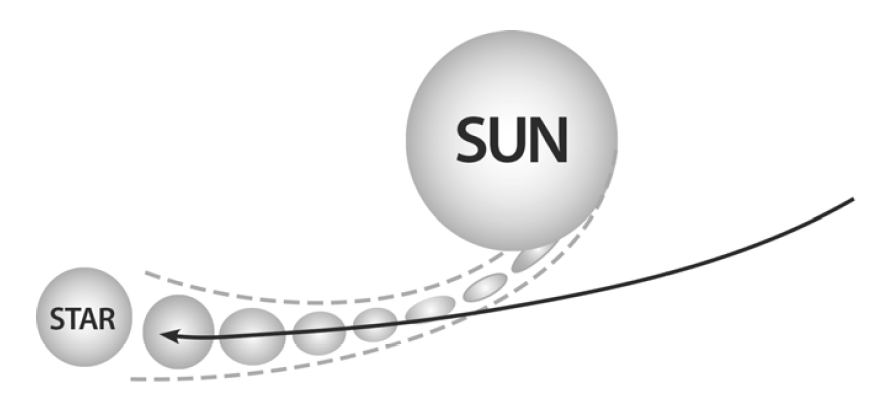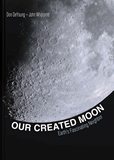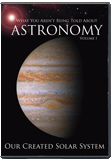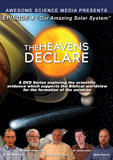
Chapter 30
What about the Origin of the Solar System and the Planets?
Secular scientists have entertained several solar system formation theories which all have issues and ignore the biblical creation narrative.
Genesis 1 tells us that God created the earth “in the beginning.” It is not until three days later on day 4 that God made the sun, moon, and stars. The Hebrew word for stars includes the planets,1 their satellites, comets, and asteroids, so we can infer that the rest of the solar system was made after the earth was. This is very different from the evolutionary view of the origin of the solar system. Most scientists today think that the earth formed about the same time as the sun and everything else in the solar system—about 4.6 billion years ago. The solar system supposedly formed gradually from the collapse of a cloud of gas and dust. Obviously, this idea is at odds with the biblical creation narrative.
We can trace the origin of the modern theory of solar system formation to Emmanuel Swedenborg in 1734, but it was Emmanuel Kant who developed the idea in 1755. Pierre-Simon Laplace proposed a similar model in 1796. This nebular hypothesis was that the solar system began as a contracting and cooling proto-solar nebula. As the nebula contracted, it flattened into a disk, and most of the material fell to the center. The material in the center formed the sun, and the material in the disk eventually coalesced to form the planets. Any remaining material formed the satellites of the planets, asteroids, and comets. The nebular hypothesis enjoyed wide support throughout the 19th century, but eventually astronomers realized there was an angular momentum problem. While the sun has more than 99 percent of the mass in the solar system, the planets possess more than 99 percent of the angular momentum. If the solar system formed via the nebular hypothesis, the distribution of angular momentum ought to be proportional to the distribution of mass. Because of this problem, astronomers abandoned the nebular hypothesis in the early 20th century.

The first replacement theory was the tidal hypothesis of Thomas Chamberlin and Forest Ray Moulton in 1905. They suggested that shortly after the sun formed, another star passed very close to the sun, raising tidal bulges on the solar surface. The tidal bulges combined with solar prominences to eject material from the sun that produced two spiral-like arms. Much of the material in the spiral arms fell back onto the sun, but some coalesced into planets. As before, leftover matter formed the satellites, asteroids, and planets.
Nebula Once "Proof" for Evolutionary Views of Universe
With both the nebular and tidal hypotheses, astronomers looked for confirmation elsewhere, and they thought that they found it in photographs of “spiral nebulae.” The word nebula comes from the Latin word for cloud. A nebula is a cloudy, indistinct, luminous object in the night sky. A few were known to the ancients, but many more were discovered after the invention of the telescope. The telescope also revealed that many nebulae actually were star clusters in which the individual stars are too faint to be seen with the eye alone. Many other nebulae remained indistinct, from which astronomers concluded that they truly were clouds of gas in space. Today, we reserve the use of the word nebula to refer to one of these, and the true nebulae probably inspired Kant and Laplace in their ideas. Many of the “nebulae” appeared flattened with bulges in their centers, and many sported spiral arms. This appearance certainly inspired Kant and Laplace, but also Chamberlin and Moulton. In fact, a century ago first drawings and later photographs of the “spiral nebulae” often were used as proof of these naturalistic theories of the solar system’s origin. I keep putting “spiral nebulae” in quotes because in 1924 Edwin Hubble showed that these were not nebulae at allt but instead were galaxies, vast collections of many billions of stars that are millions of light-years away from us. Being so far away, the stars in other galaxies appear very faint to us. Astronomers up to that time had failed to recognize that the “spiral nebulae” were distant galaxies similar to our Milky Way galaxy because their telescopes were not large enough to reveal any individual stars in them. However, in 1924, Hubble, using what was then the largest telescope in the world, was able to photograph a few of the brightest individual stars in a couple of these “nebulae.” Since 1924, it has not been proper to refer to these objects as “spiral nebulae,” though that term continued being used for decades afterward. It is important to note that for years astronomers used these objects as proof of the evolutionary view of the formation of the solar system, though astronomers eventually were forced to abandon this proof.
There were variations on the tidal interaction theme suggested by Chamberlin and Moulton. For instance, in 1918 Sir James Jeans and Sir Harold Jeffreys suggested that solar prominences were not involved and that a near miss by a passing star raised a single filament of material from the sun from which the planets and other bodies in the solar system formed. The tidal theory enjoyed broad support for much of the first half of the 20th century, but by 1940 problems had developed. One problem was that any column drawn out of the sun would dissipate rather than condense. Another problem was that material drawn out with sufficient speed to account for the angular momentum of the planets (especially Jupiter) would have left the solar system entirely, so the angular momentum problem remained. Consequently, during the middle of the 20th century, there was no agreed-upon theory for the formation of the solar system.2
Revivial of Old Nebular Hypothesis
In the 1960s, astronomers began to revive a form of the old nebular hypothesis; though, I suppose in an attempt to dissociate it from the original, that name is not used to describe the modern version. As before, the solar system supposedly formed from the collapse of a gas cloud that flattened and concentrated in its center, with the sun forming from the central condensation and the planets forming from material in the disk. The modern theory borrows a term coined by Chamberlin, planetesimal (from the words “planet” and “infinitesimal”). A planetesimal is a small body amalgamated from microscopic particles. Planetesimals supposedly grew within the proto-planetary disk to form bodies large enough to begin gravitationally attracting other planetesimals to form the planets. As before, leftover planetesimals formed planetary satellites, asteroids, and comets. And, as before, the angular momentum problem remained. The most common explanation for that problem now is that magnetic effects removed angular momentum from the inner part of the nebula and transferred it to the outer portions of the nebula in the form of spiral arms or through jets extending fore and aft out of the disks.
The modern nebular hypothesis has other problems as well. What causes the microscopic bits of matter to coalesce into planetesimals? Gravity will work only when planetesimals have grown to kilometer size. Various mechanisms have been proposed to get the planetesimals up to that size. One mechanism is that static electricity attracted particles together. Another is that sticky, organic goo coated microscopic dust particles so that they stuck together when they happened to touch. Another idea is that gaseous molecules in space froze onto solid particles. Of course, none of this is actually observed, but astronomers generally assume that it must have happened somehow, or else how did those planets get here? Another problem is what caused the gas cloud to contract to begin with. This is the long-standing problem of star formation in general. One might answer that gravity drove the process. Gas clouds do have gravity, but they also possess gas pressure, and that pressure very effectively counteracts gravity. Early in the 20th century, Jeans showed that if a gas cloud is contracted down to a certain size, gravity can take over to complete the process. The problem is that all gas clouds that we see are far larger than Jean’s length. Compression or cooling is needed to further contract the gas cloud so that gravity could complete the process. Some astronomers have suggested cooling from dust particles, but astronomers do not think that dust is primordial. Where did dust come from? This theory requires that several generations of stars must first create dust before stars could form by this mechanism. One might suppose that a gas cloud could get a sort of jump-start by an outside agent that compresses the cloud. For instance, a shock front from the explosion of a nearby supernova or associations of hot stars with strong UV radiation and stellar winds might do this, but this does not tell us where stars ultimately came from, because it requires that at least one star first exist. All theories of pre-stellar collapse of gas clouds suffer from this chicken-and-egg problem — stars must first exist to produce stars.
Modern Theory of Solar System Formation
The modern theory of solar system formation has been refined with the addition of magnetic fields. If a gas cloud contained any magnetic field initially, the magnetic field would intensify as the cloud contracted. And as the cloud contracted it would have heated and ionized some of the gas. This produces plasma. In the swirling environment of the contracting cloud, models suggest that electromagnetic effects propel material outward in the two directions along the axis perpendicular to the plane of the disk. Astronomers call this bi-polar flow, a phenomenon found in some stars and in many galaxies and quasars. In more recent years, astronomers have created computer simulations supposedly to show how the solar system might have formed. One might question if the success of the simulation merely proves that the programmer was especially good at writing a program to produce the intended outcome.
In addition to improved models, since the early 1970s astronomers have made much progress in the development of technology, such as in the infrared (IR) part of the spectrum and the superb clarity of telescopes in space. These have resulted in observations of objects that astronomers generally think are stars and solar systems in the process of forming. For instance, in 1995 the Hubble Space Telescope took the stunning “Pillars of Creation” photograph of a dark dust and gas region in the Eagle Nebula that astronomers think is the site of active star formation. Orion is a region where astronomers think new stars are forming or recently formed. In this region, astronomers have used IR telescopes to detect star-like sources embedded in clouds of dust and gas, which are regions where they think stars likely form. Astronomers have observed bipolar flows from stars or star-like objects in environments supposedly conducive for star formation, suggesting that these are stars that have nearly formed or very recently formed. Some stars have IR excess that suggest that they are surrounded by dust. The star β Pictoris was the first star discovered to have what appears to be a disk of dust surrounding it. This was interpreted as a protoplanetary disk that may yet condense into planets. More recently, astronomers have found disks of material around other stars that astronomers think are very young. All of these sorts of things have been put forth as proof of the prevailing theory of solar system formation.
But is this proof? The process of solar system formation is supposedly a very slow one, progressing far too slowly for us to witness any real change even in many human lifetimes. So these data all amount to sorts of snapshots of various stars and other astronomical bodies supposedly in various stages of the process of stellar and planetary formation but with no real evidence that these objects are actually undergoing the alleged processes. Rather, these snapshots are interpreted in terms of the ruling paradigm of solar system formation, and then they are offered up as proof of that paradigm. This amounts to circular reasoning, which is no proof at all. Remember that a century ago astronomers used the photographs of “spiral nebulae” as proof of the then-prevailing ideas of solar system formation. At the time, nearly everyone was convinced of the correctness of this view, but later observations proved otherwise. The supposedly iron-clad proof of solar system formation today could be interpreted very differently in just a few years. In fact, the history of science strongly suggests that the current paradigm of solar system formation eventually will be discarded.
Star Formation Today?
Do stars form today? Biblically, we do not have a clear answer. Some recent creationists think that since Genesis 1 records that God made the stars on day 4, no more stars are being made. But Genesis 1 also tells us that God made horses on day 6, but new horses are born every day. While no one has never observed the formation of new stars, there is no reason why stars could not form today (e.g., it would not be inconsistent with a biblical worldview). The question is whether the star formation rate today is nearly great enough as required by the evolutionary paradigm.
In the 1990s, astronomers first discovered planets orbiting other stars. Since then the number of extra-solar planets has grown tremendously. This has shown that planets must be common in the universe, and hence planetary system formation must be common in the universe today. However, this conclusion stems entirely from an evolutionary worldview. That is, the assumption is made that planetary systems can arise only through natural means apart from a Creator. Therefore, if planetary systems are common, then all of them must have come about through evolutionary processes. Since planetary systems are common, planetary formation must be simple and straightforward, which proves that our solar system must have formed through such a process. Therefore, the solar system formed pretty much the way astronomers think that it did. Of course, this is circular reasoning, and no such inference of naturalism legitimately can be drawn. A creationist could just as easily state that since all things were made by God, then anything that exists was made by Him. Since so many other planetary systems exist, then God must have made them all, just as He made our solar system. Therefore, this proves creation. Of course, evolutionists would violently disagree with this conclusion, for it disagrees with their starting premise of naturalism. This illustrates that the data alone do not allow for a definite conclusion about the ultimate origin of planetary systems, including our own.
The purpose of looking for extra-solar planets is to show how common planets are and how typical our solar system is. But is our solar system common? The evidence thus far suggests otherwise. In our solar system, the large gas giant planets are far from the sun and the small rocky planets are close to the sun. Planetary scientists have developed models of how this might have happened, and those theories indicate that the large gas giant planets ought to be far from the sun, as is the case in the solar system. But extra-solar planets tend to be very large and very close to their parent stars,3 the opposite of the situation in the solar system, and contrary to the prevailing theories of planetary formation. Scientists have concocted multiple encounters of planets (again using computer simulations) to show how extra-solar planets might have formed far from their stars but then migrated inward. Evolutionists must devise these explanations because the observations defy their theories.
Planet Formation: Evolution vs. Revelation
Evolutionary ideas of planetary formation are fraught with problems. Man’s ideas about the origin of the solar system have changed, and they will continue to change. However, the Word of God does not change. While the Bible does not tell us much about how the solar system came into being, it does give us some information about when the earth and the rest of the solar system came into existence. The Christian has confidence that what God has revealed to us is true, so we ought to compare man’s ideas to the revealed truth. The current thinking of solar system formation disagrees with the Genesis creation account, so we know that it is not correct.
The New Answers Book 4
Building on the previous New Answers Books, learn more about the Gospel and a young earth, death of plants and leaves, dragons, religious wars, cavemen, science, living fossils, and more.
Read Online Buy BookFootnotes
- Our English word planet comes from asters planetai, ancient Greek for “wandering stars.” Ancient languages defined a star as any luminous object in the sky other than the sun and the moon.
- Though it was far out of date, this theory was in science texts used in my elementary school in the mid-1960s. Those books were not very old, but this theory was probably included because there was no other alternative.
- With time, this situation might change. Observational bias is in favor of finding massive planets close to their host stars. With improvements in technology, we may eventually find smaller and more distant planets more easily.
Recommended Resources

Answers in Genesis is an apologetics ministry, dedicated to helping Christians defend their faith and proclaim the good news of Jesus Christ.
- Customer Service 800.778.3390
- © 2024 Answers in Genesis





